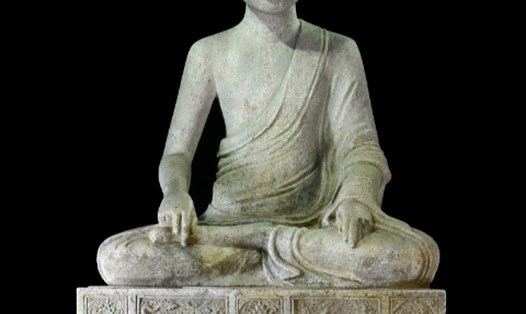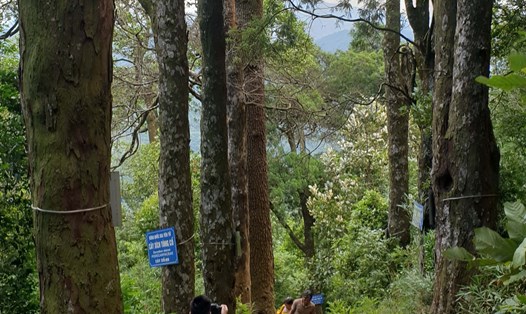If these two more national treasures are found, there will be three national treasures on the sacred Yen Tu mountain, all located outside the site. Among them, the statue of Buddha King Tran Nhan Tong, located in the Hue Quang tower garden, was recognized as a national treasure at the end of 2020.
According to Mr. Tran Trong Ha - former Director of Quang Ninh Museum - the Buddha stele is one of the particularly important relics in the history of formation and unique cultural value of the sacred Yen Tu mountain.
On the pilgrimage to Dong Pagoda, in the area of the Heaven Gate about 50m below the Dong Pagoda, there is an ancient sedimentary rock field, mixed with gravel, soil, and sand, with a fairly solid and durable structure, with large blocks of stone stacked on top of each other, and some sections are steps.
From afar, this rock formation looks like thousands of “linh quy” (sacred turtles) facing the sacred peak of Yen Tu. There is a natural stone slab standing straight up to the sky, shaped like a large oan (rice cake) offered to Buddha. This is the Buddha stele - a large and thin sedimentary rock block, about 5m high (not including the underground part), more than 2.5m wide at its widest point, and about 0.5m thick. The stele weighs about 8 tons.
With a shape small at the top and large at the bottom, like a Linh Son mountain, the stele faces southwest in the same direction as Dong Pagoda - that is, towards the land of Buddha.
On the front of the stele are engraved two perpendicular lines of letters, one vertical and one horizontal, but some of the letters have faded. Only the word “Buddha” in the four vertical letters “A-Di-Da-Phat” and the four horizontal letters “Tu Tu Hong Danh” are still quite clear.
According to the Management Board of Yen Tu National Forest and Relic Site, the words on the Buddha stele were carved a long time ago but it is not clear who carved them.
The inscriptions on the stele are placed in circular boxes in the style of seal script, the strokes are full, precise and very beautiful. According to former Director of Quang Ninh Museum Tran Trong Ha, this shows the respect for Buddhism of the person who initiated the inscriptions as well as the diligence of the inscriber.
The Buddhist stele has affirmed the presence and important role of Buddhism on the sacred Yen Tu mountain in particular as well as in the spiritual life of the Vietnamese people in general many centuries ago.










